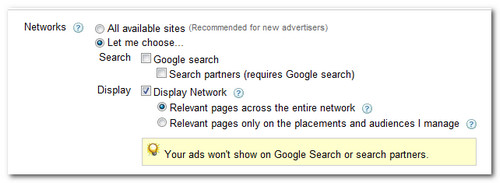The Google content network has huge reach. It’s also a lot cheaper than advertising on the search network, yet the conversion rates can be much the same.
Whilst the content network has had a bad reputation in the past, this has often been due to poorly targeted campaigns. Marketers have simply copied their existing search campaigns to the content network, and failed miserably.
The content network requires a different strategy. There are two key aspects to doing well on the content network: distraction and demographics.
Distract Your Audience
When a person searches Google, they are actively looking for something specific. When a text ad matches their search, they are likely to consider it relevant, and click on it.
Contrast this activity with the content network.
On the content network, the reader is viewing a page of content. They aren’t necessarily hunting for something specific. The advertising, therefore, is peripheral. Advertising on the content network needs to distract visitors away from their activity.
The content network offers more formats than the search network. You can run text, video and graphical ads. They are also different sizes and shapes. Here’s a rundown on the formats from Google.

You should develop ads in a number of different formats to test which works best for you. I recommend you create ads for the most common first, which are the Leaderboard (728x 90), the Medium Rectangle (300×250) and the Wide Skyscraper (160 x 600). Move on to the other sizes if you need more reach, or to target sites that only offer specific formats.
Of course, if you’re only using text ads, you don’t need to consider ad format sizes, but I strongly suggest you do develop graphical advertising. It gives you more options to distract.
When advertising on the content network, don’t be afraid to be outrageous. Remember, you’re aiming to distract people. So use imperatives! Offer free stuff. Use all the hooks of the direct marketing trade. In particular, focus on strong benefit statements.
You have very little time to make an impression with people who don’t actually have your product or service in mind. Advertising on the content network is more like print and television advertising than search advertising. The search network is about seeking. The content network is about discovery. To create and drive demand.
Separate out your content advertising from your search advertising. Run two separate campaigns. Don’t simply run the exact same campaign you are running on the search network.

The two are very different beasts.
Identify Your Market…..Right Down To The Individual
Because the Google content network attempts to match your ads to pages it determines your visitors might read, it pays to know who you buyer is, and what they are reading.
For example, grab a celebrity magazine and flip through the advertising. You’ll likely find weight loss advertisements, grooming advertisements, etc. This is because the advertisers have identified their target demographic. They know that people who are interested in celebrities are also likely to be interested in products a, b & c. You can do the same thing online.
In the above example, the keywords in the ad group would need to include keywords related to celebrities, even though the advertisement is advertising weight loss products.
Specifically, use the Adwords placement tool to find sites that match your chosen demographic. Examine the copy those sites use and look for commonly occurring keyword terms. Use SEO keyword frequency analysis tools to help you.

Use the most common terms as the basis for your keyword list. This way, you’ll appear on sites that closely match your demographic. You’ve given Google the terms that would most likely appear in their copy. Remember to still use negative operators on keywords that don’t appear to fit.
Keyword terms should also be specific. Try to avoid using terms that have double meanings i.e. Apple could mean a fruit, or Apple computers.Use two or three word phrases, where necessary, to add clarity.
The Adwords placement tool is very powerful. Once you’ve established your demographic, you can drill down further by targeting specific sites. You can tailor ads and entire campaigns for just those sites.
Ask yourself: who is the customer? What are their favorite TV shows? What magazines do they read? What are their interests? What are their favorite websites? Seek out sites that fit the demographic. Use the same keywords in your keyword list as they do in their copy. Target you advertisements directly to the the most appropriate sites. Your job is then to distract readers enough so they click on your ads. At least you’re in front of the right crowd!
Identifying and isolating demographics, and learning the art of distraction, is key to success on the content network.




The Content Network was recently re-branded to the Display Network.
Good info, Peter. A Google rep told me the additional info below:
Google’s Display Network works best with even tighter groupings of keywords than search as it uses an algorithm to determine the pages on which your ad will appear. It also disregards match types. The Display Network algorithm takes longer (several weeks usually) to find the best pages for your ads, so if you’re looking to gain a lot of exposure quickly it is often necessary to overbid initially.
08.18.10 at 9:14 am
I like the “Identify Your Market…..Right Down To The Individual” part. I’ve been running a campaign in Google content network for 3 years now. Though conversion rate is not as good as what I’m getting from the search network, the campaigns are doing good in terms of ROI. I’m on a different niche though where images really don’t convert. But after reading this, I’ll try the images again.
08.19.10 at 3:12 am
I have to say, Mastering The Google Content Network ~ PPC Blog is a honestly nice blogging site. I might like to offer you my thank you. Heed!
04.21.12 at 5:58 am